A/C works great and is very cold, but when I go up a hill or the engine is under a pretty good load the A/C won't blow as hard. Let off the gas to let manifold vacuum come back and the A/C returns to blowing normal. Cruising along on flat ground no difference. I'm assuming this is a vacuum related issue but don't know where to start with it. Anyone got any tips?
You are using an out of date browser. It may not display this or other websites correctly.
You should upgrade or use an alternative browser.
You should upgrade or use an alternative browser.
1996 Bronco A/C Troubleshooting
- Thread starter f2502011
- Start date
Disclaimer: Links on this page pointing to Amazon, eBay and other sites may include affiliate code. If you click them and make a purchase, we may earn a small commission.
yo,
The most common AC vac leak area is at vacuum hose to Outside Recirculate Door Vacuum Motor; on passenger side near firewall and hood hinge
pic by JohnMcD348 at http://i38.photobucket.com/albums/e147/johnmcd348/Bronco%20Vacuum%20Fix/IMG_3429Small.jpg
Ck vacuum supply hose to be sure it is connected to both the engine manifold and the A/C vacuum check valve
More 96 Tests
The air handling system is designed to provide defrost when no vacuum is applied to any of the three air door vacuum control motors. This is done to prevent a situation where defrost cannot be obtained due to a system vacuum leak. Instead, a leak in the vacuum control circuit will send all airflow to the defroster outlets. This condition may occur during acceleration (small leak), may exist at all times (large leak) and may happen only when certain specific functions are selected, indicating a leak in that portion of the circuit.
The vacuum hoses used in the passenger compartment control circuit are constructed of polyvinyl-chloride (PVC) plastic material. The vacuum hoses used in the engine compartment are constructed of Hytrel. Because of the materials used, the vacuum hoses should never be pinched off during diagnosis to locate a leak. Use Rotunda Vacuum Leak Tester or equivalent to locate vacuum leaks. A wood golf tee can be used as a plug when it is necessary to plug one end of a vacuum hose for leak test purposes.
HVAC Diagram in a 95
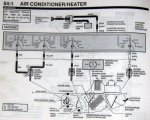
Source: by Seabronc (Rosie, Fred W) at Ford Bronco Zone Forums
I have more HVAC vac stuff likns in my site @ http://www.broncolinks.com/index.php?index=87
The most common AC vac leak area is at vacuum hose to Outside Recirculate Door Vacuum Motor; on passenger side near firewall and hood hinge
pic by JohnMcD348 at http://i38.photobucket.com/albums/e147/johnmcd348/Bronco%20Vacuum%20Fix/IMG_3429Small.jpg
Ck vacuum supply hose to be sure it is connected to both the engine manifold and the A/C vacuum check valve
More 96 Tests
The air handling system is designed to provide defrost when no vacuum is applied to any of the three air door vacuum control motors. This is done to prevent a situation where defrost cannot be obtained due to a system vacuum leak. Instead, a leak in the vacuum control circuit will send all airflow to the defroster outlets. This condition may occur during acceleration (small leak), may exist at all times (large leak) and may happen only when certain specific functions are selected, indicating a leak in that portion of the circuit.
The vacuum hoses used in the passenger compartment control circuit are constructed of polyvinyl-chloride (PVC) plastic material. The vacuum hoses used in the engine compartment are constructed of Hytrel. Because of the materials used, the vacuum hoses should never be pinched off during diagnosis to locate a leak. Use Rotunda Vacuum Leak Tester or equivalent to locate vacuum leaks. A wood golf tee can be used as a plug when it is necessary to plug one end of a vacuum hose for leak test purposes.
HVAC Diagram in a 95

Source: by Seabronc (Rosie, Fred W) at Ford Bronco Zone Forums
I have more HVAC vac stuff likns in my site @ http://www.broncolinks.com/index.php?index=87
Thanks for the info. I was going up a hill today under load on Norm A/C high fan and after a few seconds on the steep grade it switched to mostly cold air coming out the defrost vents. Let off on the other side of the hill and back to blowing out the dash vents. The control circuits seem to work like they're supposed to and the vacuum lines are all in great shape. So I have a small leak in the vacuum control circuit?? What exactly does that mean and where should I start?
Last edited by a moderator:
yo,
YW,
Yes, you have a small leak in the vacuum control circuit;
The vac leak could be in a hose that is ruptured or not connected to a device such as Outside Recirculate Door Vacuum Motor; on passenger side near firewall and hood hinge
This is most common leak ara because when hood is open UV rays play havoc on that vacuum hose; and some are damaged while repairs are done on other items.
Here it is in another pic

right click on image and open in new window to enlarge pic
pic by Ken showing white vacuum hose is discnnectesd from "Vacuum Motor"
Your white & other HVAC vacuum hose could have been replaced w/black hose by previous owner or shop.
Five hoses (black, white, red, blue, yellow) extend from the A/C control just below the electrical connector for the mode selector switch to the vacuum control motors and vacuum supply.
The solid black hose goes to the vacuum supply through a tee-shaped A/C vacuum check valve (19A563), which attaches the A/C vacuum reservoir tank and bracket (19A566) and engine source; vacuum check valve blocks airflow in one direction and frees airflow in the other direction. The check side of this valve will hold the highest vacuum seen on the vacuum side. If not, replace it.
The white hose actuates the Outside Recirculate Door Vacuum Motor.
The blue hose actuates the FLOOR/PANEL air door two-position vacuum control motor.
The red and yellow hoses actuate the FLOOR/DEFROST three-position air vacuum control motor. Each end of each hose slides onto the ****** of the vacuum port to which it attaches.
VACUUM LEAK CHECK
On an idling engine check for vacuum leaks using a mechanic's stethoscope with the probe removed, or a ~3' garden hose section. BEWARE of fab, belts, pulleys and hot engine/hoses.
see my vacuum leak post here for more possible leak areas @ http://broncozone.com/topic/22770-low-idle/
If hose and "motor" look and test (use soda straw sucking test by pulling hose and placing one finger over one end and **** air through other) good;
Follow that white vacuum hose Recirculate Door Vacuum Motor from motor back inside to control panel; inspect there
then look @ other HVAC Hoses
If you can not foind the leak; let us know. You could use the propane gas test to find it, but that is not so good if you never did it before.
YW,
Yes, you have a small leak in the vacuum control circuit;
The vac leak could be in a hose that is ruptured or not connected to a device such as Outside Recirculate Door Vacuum Motor; on passenger side near firewall and hood hinge
This is most common leak ara because when hood is open UV rays play havoc on that vacuum hose; and some are damaged while repairs are done on other items.
Here it is in another pic

right click on image and open in new window to enlarge pic
pic by Ken showing white vacuum hose is discnnectesd from "Vacuum Motor"
Your white & other HVAC vacuum hose could have been replaced w/black hose by previous owner or shop.
Five hoses (black, white, red, blue, yellow) extend from the A/C control just below the electrical connector for the mode selector switch to the vacuum control motors and vacuum supply.
The solid black hose goes to the vacuum supply through a tee-shaped A/C vacuum check valve (19A563), which attaches the A/C vacuum reservoir tank and bracket (19A566) and engine source; vacuum check valve blocks airflow in one direction and frees airflow in the other direction. The check side of this valve will hold the highest vacuum seen on the vacuum side. If not, replace it.
The white hose actuates the Outside Recirculate Door Vacuum Motor.
The blue hose actuates the FLOOR/PANEL air door two-position vacuum control motor.
The red and yellow hoses actuate the FLOOR/DEFROST three-position air vacuum control motor. Each end of each hose slides onto the ****** of the vacuum port to which it attaches.
VACUUM LEAK CHECK
On an idling engine check for vacuum leaks using a mechanic's stethoscope with the probe removed, or a ~3' garden hose section. BEWARE of fab, belts, pulleys and hot engine/hoses.
see my vacuum leak post here for more possible leak areas @ http://broncozone.com/topic/22770-low-idle/
If hose and "motor" look and test (use soda straw sucking test by pulling hose and placing one finger over one end and **** air through other) good;
Follow that white vacuum hose Recirculate Door Vacuum Motor from motor back inside to control panel; inspect there
then look @ other HVAC Hoses
If you can not foind the leak; let us know. You could use the propane gas test to find it, but that is not so good if you never did it before.
Seabronc
New member
You might want to also check the condition of the vacuum reservoir. It is there to prevent that problem bu making up for the loss of vacuum when the engine is under load. There is a check valve that allows it to store vacuum for use under engine load conditions like going up hill.
Good luck,

Good luck,
Thanks for all the great info. I'm sure you've already answered it, but for some reason I am having trouble pinpointing where I should start or deciphering all the info. Is there a most likely culprit or a maybe a more basic answer to this problem other than checking all the lines for leaks? The only thing it is doing is switching to the defrost vents when under load. The hoses are all original and in good shape and all connected.
Seabronc
New member
In my opinion, your most likely suspect is the vacuum reserve. The reason for saying that is, that your system works when there is low load on the engine which is also when the vacuum system is at its maximum. A low or no vacuum situation causes the vent system to go to it's default which is the defroster vents. That is a safety feature. The reservoirs function is to supply vacuum to the vent control when the engine is under load in order to prevent just what is happening to your system. The switch to reservoir vacuum supply is controlled by a 3 port check valve.
I don't recall seeing what year truck you have. That would help in being more precise since the hardware is different.

I don't recall seeing what year truck you have. That would help in being more precise since the hardware is different.
It's a 1996In my opinion, your most likely suspect is the vacuum reserve. The reason for saying that is, that your system works when there is low load on the engine which is also when the vacuum system is at its maximum. A low or no vacuum situation causes the vent system to go to it's default which is the defroster vents. That is a safety feature. The reservoirs function is to supply vacuum to the vent control when the engine is under load in order to prevent just what is happening to your system. The switch to reservoir vacuum supply is controlled by a 3 port check valve.
I don't recall seeing what year truck you have. That would help in being more precise since the hardware is different.

yo,
OK,
I see that too much info can be overwhelming, sorry;
open hood
got to passenger side hood hinge and look into corner where firewall meets fender
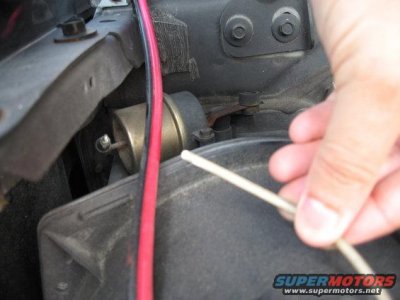
see if thevacuum hose is broken, or leaking vacuum, or disconnected from that vacuum motor behind the red and balck hoses.
This is the vacuum motor in a pic by John D
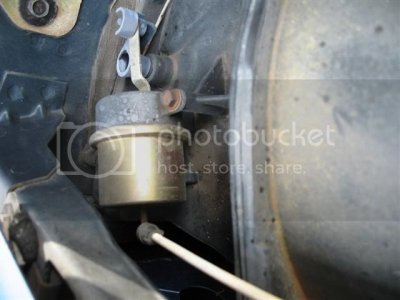
EDIT 9 OCT 2012
The HVAC Vacuum tank location is inside the engine compartment
Check Valve & Tank Location pic in a 93; "...valve is about a foot down the vacuum line coming off the 'tree' on the engine Plenum. One of the lines on the check valve tee goes to the built-in reservoir on the a/c box, the other into the loom with the white tube heading for the control panel inside ..." by garymunson
and diagram by Ford
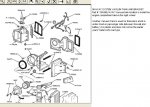
=========================================
Another Vacuum Tank is used for Emissions and it is under hood on passenger side between firewall and battery; it is plastic and does not rust as the earlier years' metal coffee can type
here is a pic of the 96 EMission tank
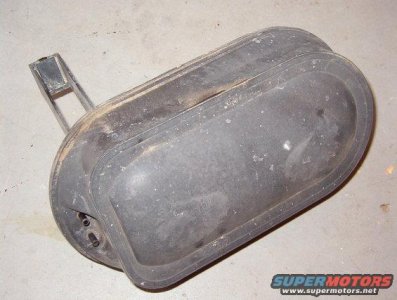
OK,
I see that too much info can be overwhelming, sorry;
open hood
got to passenger side hood hinge and look into corner where firewall meets fender

see if thevacuum hose is broken, or leaking vacuum, or disconnected from that vacuum motor behind the red and balck hoses.
This is the vacuum motor in a pic by John D

EDIT 9 OCT 2012
The HVAC Vacuum tank location is inside the engine compartment
Check Valve & Tank Location pic in a 93; "...valve is about a foot down the vacuum line coming off the 'tree' on the engine Plenum. One of the lines on the check valve tee goes to the built-in reservoir on the a/c box, the other into the loom with the white tube heading for the control panel inside ..." by garymunson

and diagram by Ford

=========================================
Another Vacuum Tank is used for Emissions and it is under hood on passenger side between firewall and battery; it is plastic and does not rust as the earlier years' metal coffee can type
here is a pic of the 96 EMission tank

Attachments
Last edited by a moderator:
Similar threads
- Replies
- 2
- Views
- 144
- Replies
- 1
- Views
- 488


